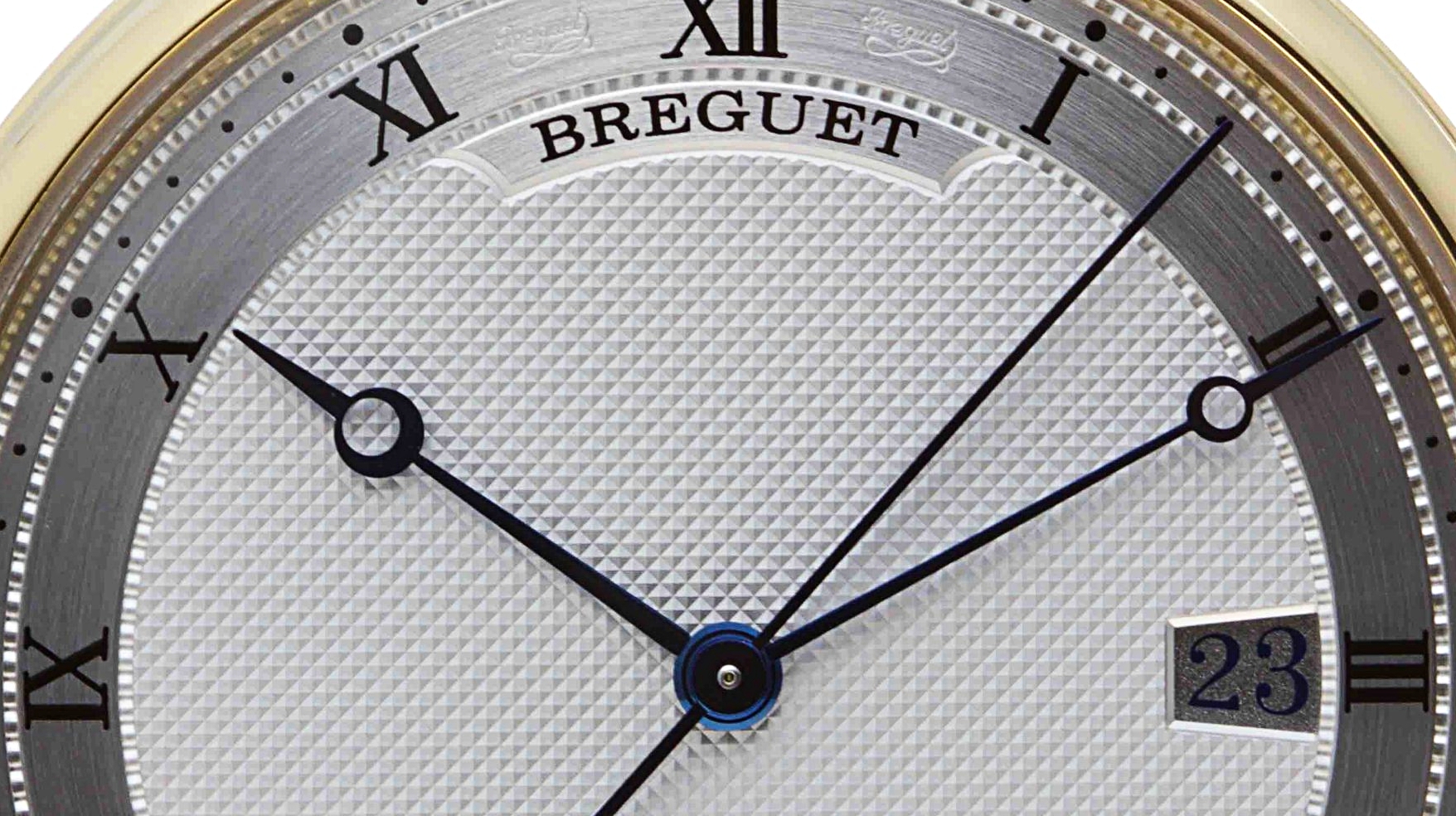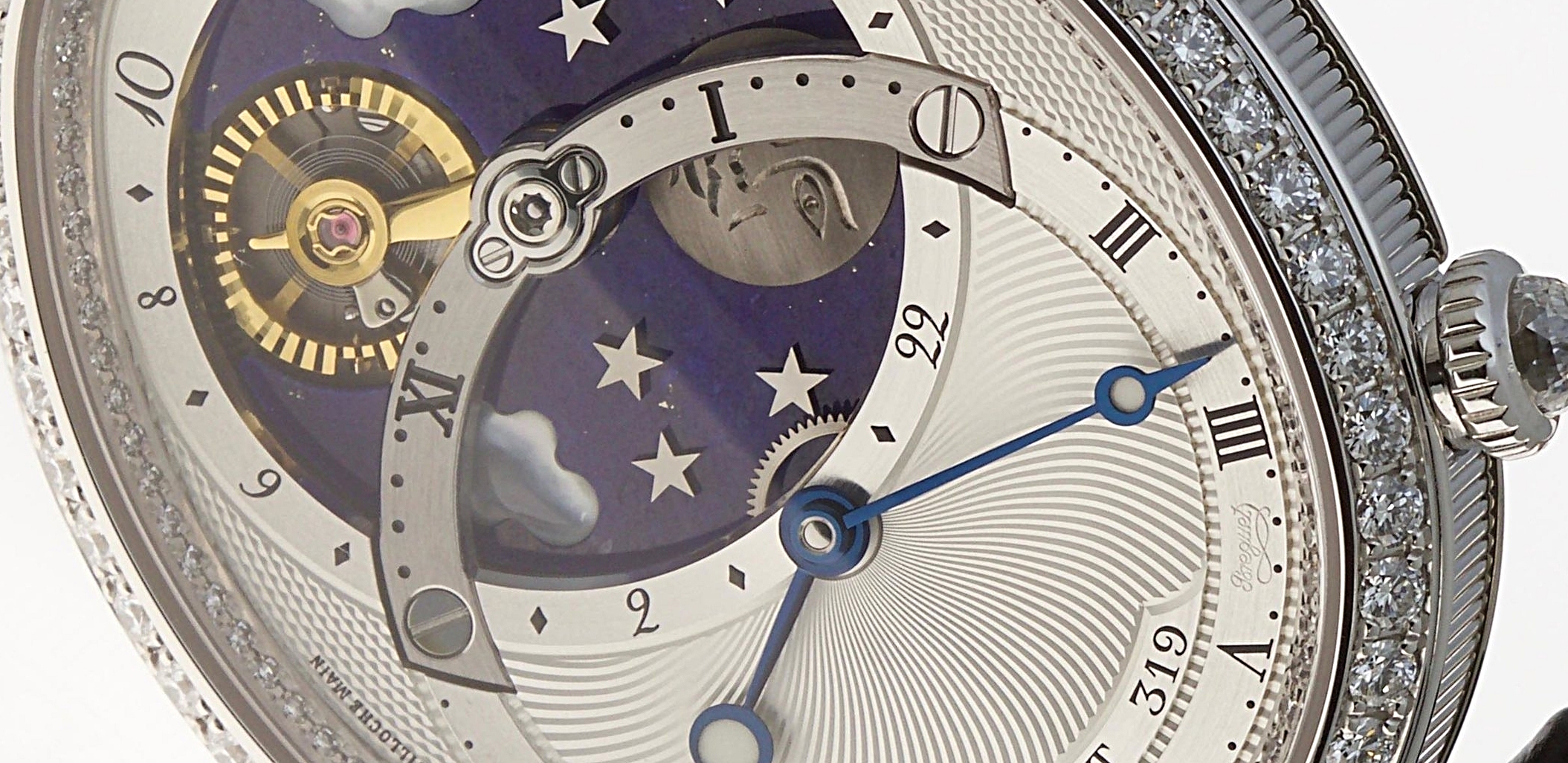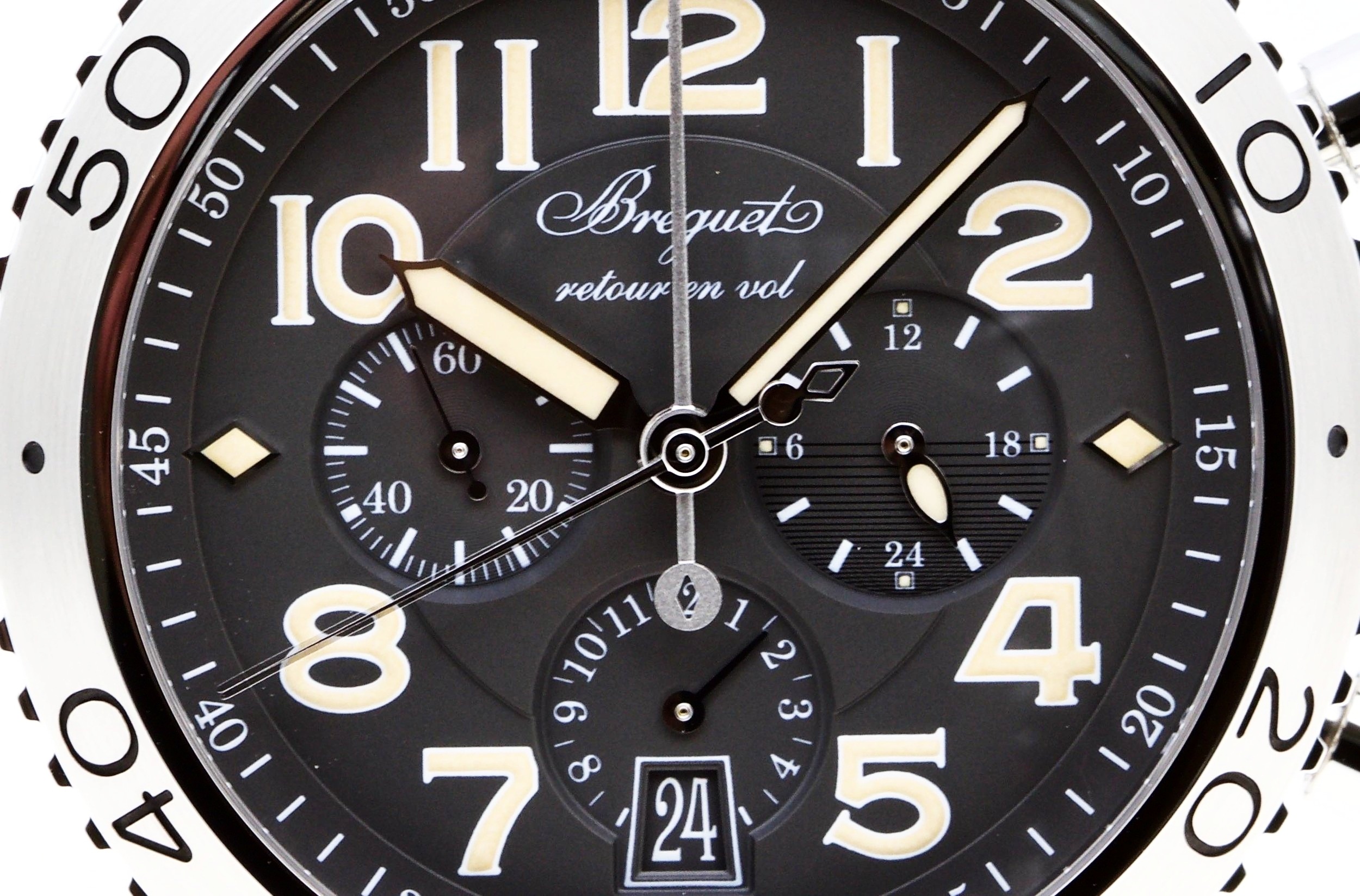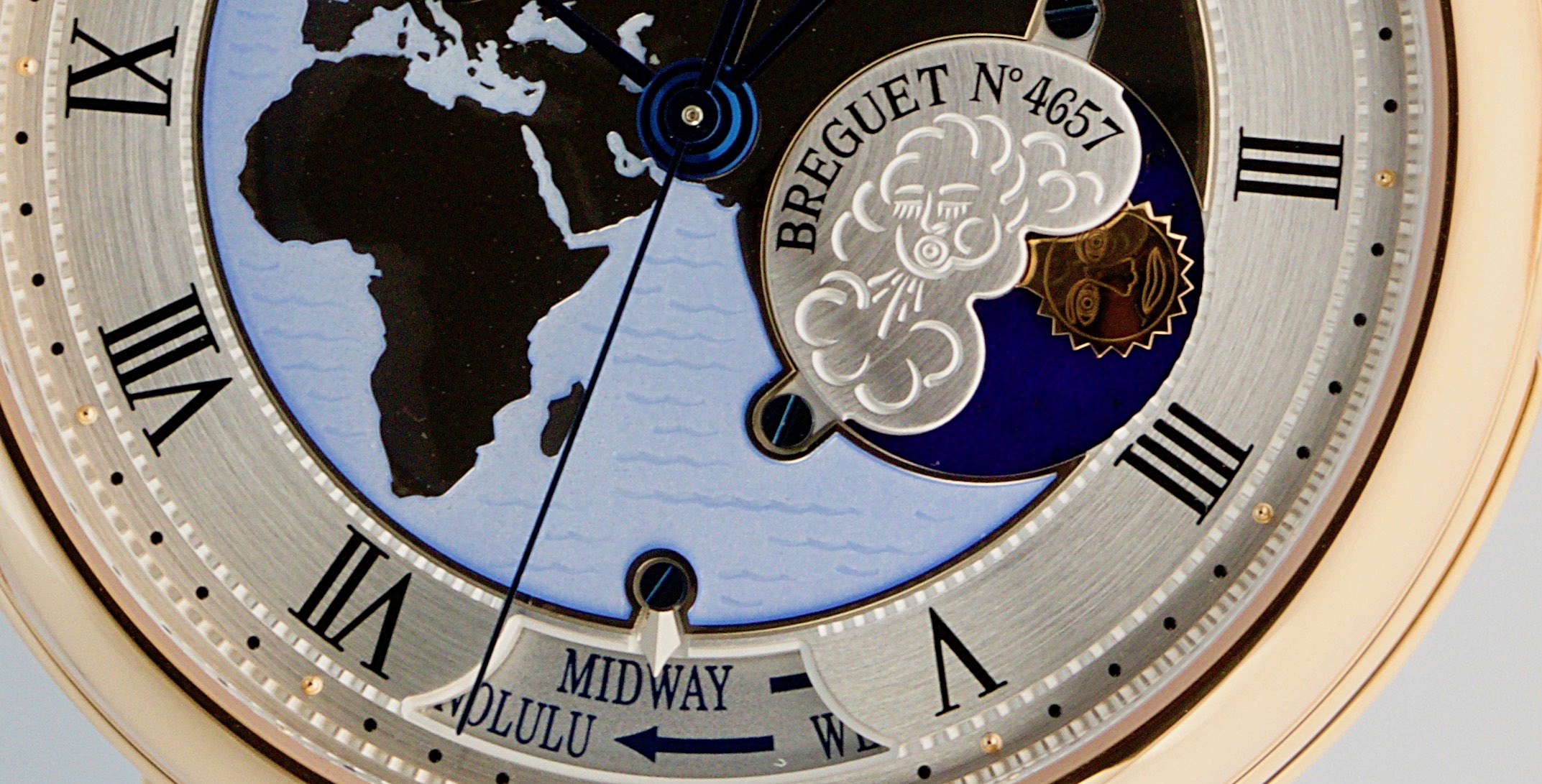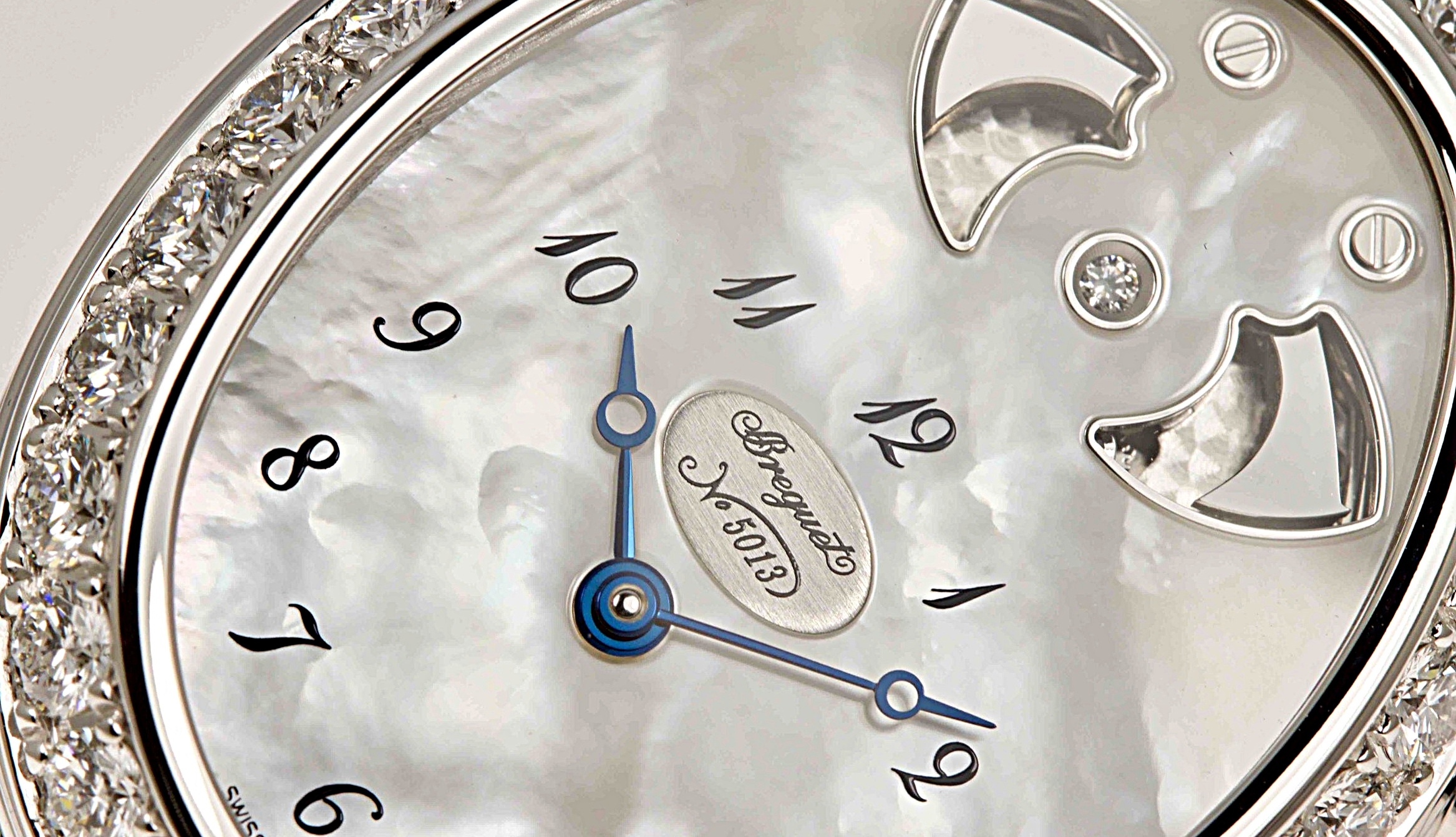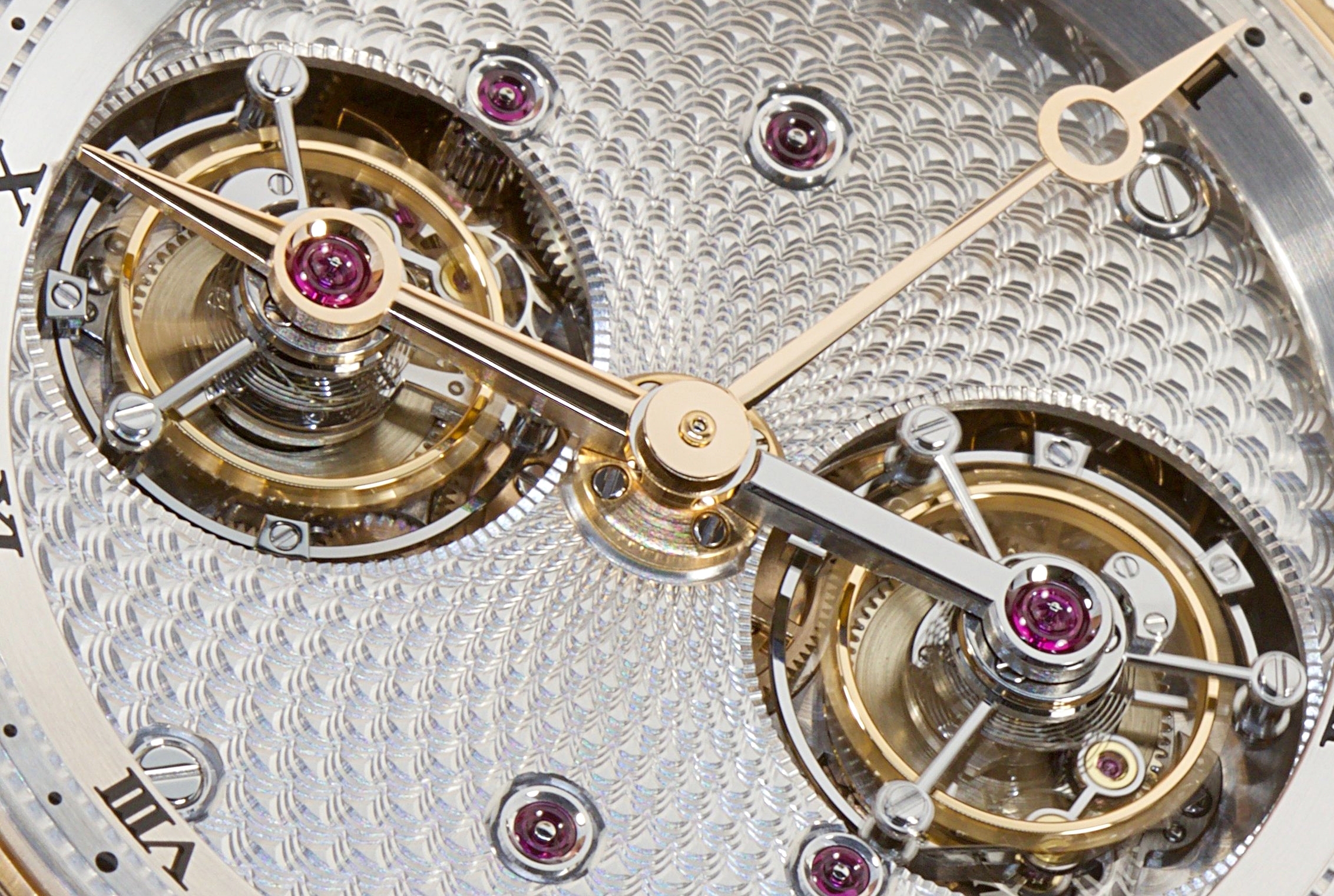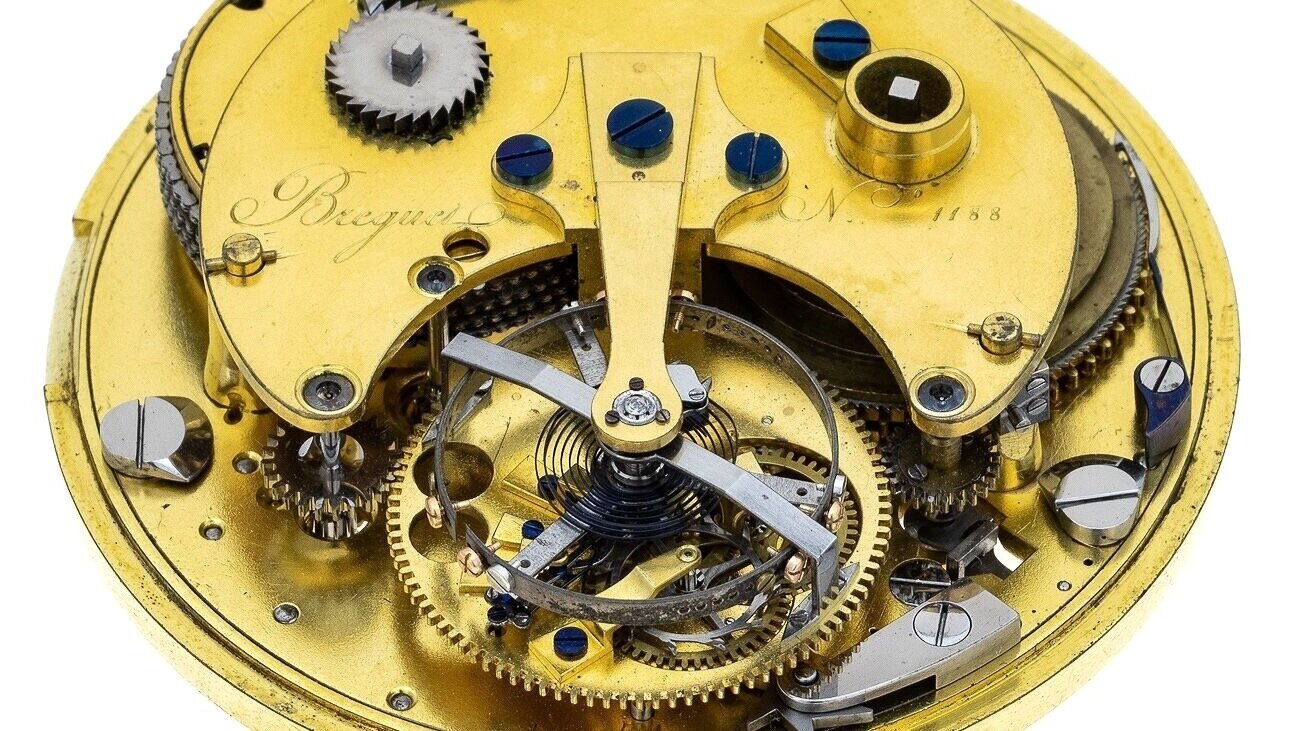Please click on an image below
The history of Breguet spans 200 years. An entire volume could easily be dedicated to the life of its founder and further volumes to the evolution of the company since then.
All of it is important, as each period is an evolution from the previous era, hence the decision to share the full press details provided by Montres Breguet SA. We have provided two elements that are decisive in the development of the modern day brand.
Below you will find an abridged version of the history, a note on the Nicolas G. Hayek years and the chronology provided that links both.
Breguet History – Abridged
A.-L. Breguet
Born in Neuchâtel, Switzerland, in 1747, Abraham-Louis Breguet spent much of his life in Paris. Responsible for a host of inventions: the automatic watch, referred to as “a perpetual”, the spring gong for repeater watches, and the first shock-absorber device, the “pare-chute”. The Breguet balance spring, the first travelling clock, the “sympathique” clock, the montre à tact, and possibly the most significant the tourbillon, patented on June 26, 1801.
Abraham-Louis Breguet became a member of the Bureau des longitudes in Paris and the Chronometer-maker to the French Royal Navy. He also entered the Academy of Science and received the Legion of Honour from King Louis XVIII.
Such was his success, the following historical figures count among their client list.
Marie-Antoinette, Queen of France (1782)
Louis XVI of France (1783)
Charles-Maurice de Talleyrand-Périgord (1787)
The Marquise de Condorcet (1792)
Empress Joséphine (1798)
Napoleon Bonaparte (1798)
General Charles Victor Emmanuel Leclerc (1801)
The Prince of Wales (1803)
Giovanni Paisello (1804)
The Prince of Würtemberg (1805)
Selim III, Sultan of the Ottoman Empire (1806)
Caroline Murat, Queen of Naples (1807)
Tsar Alexander I of Russia (1809)
George III of England (1810)
On his death in 1823, his eulogy read that A.-L. Breguet was a man whose genius had revolutionized every aspect of timekeeping.
Breguet, renaissance
Breguet enjoyed uninterrupted history through three successive owners, before being acquired, (see chronology) by The Swatch Group. In 1999, Nicolas G. Hayek took control of Breguet. Under his leadership and foresight, plans were put in place for the future of Breguet, a strategy to modernise and provide Breguet with the tools it needed to embark upon a new era..
Considerable investment was made on the expansion of the infrastructure. Investment in R&D as well as the latest control technology and Initiating work on new materials with the application of silicon in watchmaking. Emphasis has been placed in the continual development of movements with the goal to re-establish Breguet as a benchmark in contemporary Fine Watchmaking, building on its already established heritage.
Despite the untimely passing of Nicolas G Hayek, his actions have left Breguet in a commercial position of strength, and a workforce that recognises the importance of his actions.
Today the President of Breguet is Marc A. Hayek, the CEO Mr Thierry Esslinger and Mr Emmanuel Breguet Vice President for Patrimony and Marketing.
Breguet Chronology
1747. Birth in Neuchâtel (principality of Neuchâtel) on 10 January of Abraham-Louis Breguet, son of Jonas-Louis and Suzanne-Marguerite Bolle.
1762. Arrival in France of Abraham-Louis Breguet (aged 15). Apprenticeship at Versailles and afterwards Paris. Receives instruction in the sciences from Abbé Marie.
1775. Abraham-Louis Breguet sets up his own business on Quai de l’Horloge, Ile de la Cité. Marriage of Abraham-Louis Breguet (aged 28) and Cécile L’huillier (aged 23), in the church of Saint-Sulpice in Paris.
1776. Birth of Antoine-Louis Breguet.
1780. Launch of the first self-winding watches known as ‘perpétuelle’, with an oscillating weight and two going-barrels. Death of Cécile L’huillier-Breguet (aged 28).
1783. Invention of gong-spring for repeating watches. Design of hands with hollowed-out points known as ‘Breguet hands’ and of Arabic numerals known as ‘Breguet numerals’.
1784. Abraham-Louis Breguet received as master in the guild of watchmakers and clockmakers.
1786. First guilloché dials. Report to the government on a plan to set up a manufactury and school of watchmaking in Paris. Improvement of the English lever escapement.
1787. Partnership with Xavier Gide, dealer in clocks and watches.
1788. Deposit with the Academy of Sciences of a sealed envelope containing the description of a ‘Three-wheel clock’.
1789. Invention of the ratchet key known as the ‘Breguet key’. Natural escapement, functioning without lubrication. Journey to England (May-June).
1790. Invention of the ‘pare-chute’ antishock device, to reach its final form in 1806.
Journey to England (April-July).
1791. ‘Jump seconds’ watches. Appearance of ‘new calibre’, derived from Lépine’s calibre. Journey to England (January-May). Partnership with Xavier Gide ended.
1792. Now a French citizen, Abraham-Louis Breguet is enlisted in the Garde Nationale. Construction of mechanism for Chappe’s optical telegraph, completed in early 1793.
1793. Abraham-Louis Breguet flees the turmoil of the Revolution, leaving Paris for Switzerland (August). Stays in Geneva before arriving in Neuchâtel (November).
1794. Leaves Neuchâtel for Le Locle at the end of the year. Sets up a small workshop. The Quai de l’Horloge workshop, still active, is ransacked and evicted by force.
1795. Return to Paris of Abraham-Louis Breguet (May). Final version of ruby cylinder escapement crowns fifteen years of work on the subject. Development of perpetual calendar. Invention of ‘Breguet overcoil’. First description of the ‘sympathique clock’ in a letter to his son.
1796. The workshops return to their former premises. Abraham-Louis Breguet draws up a summary of his inventions. Construction of the first carriage clock. Development of a new optical telegraph with the Spanish engineer Bétancourt. Sale of the first ‘souscription watch’, a new development launched the following year with the aid of a publicity brochure.
1798. Patent of the constant force escapement (9 March). Presentation of the first sympathique clock, which sets and winds a watch placed in a cradle. Musical chronometer. Gold medal at the National Exhibition of the Products of Industry.
1799. Sale of the first ‘tact watch’.
1801. Patent of the ‘tourbillon regulator’ (26 June). This invention, conceived in 1795, was not to be marketed until 1805.
1802. Gold medal at the National Exhibition of the Products of Industry.
1804. Birth of Louis-Clément Breguet, son of Antoine-Louis and Jeanne-Françoise Venture de Paradis.
1806. First public presentation of the tourbillon. Endorsement of gold medal at the National Exhibition of the Products of Industry.
1808. Opening of Russian outlet, the ‘Maison de Russie’, closed down in 1811. Breguet is granted the official appointment of Horologer to his Majesty and to the [Russian] Imperial Navy.
1810. Manufacture of first wristwatch, commissioned by the Queen of Naples. It was completed in 1812.
1811. Anonymous publication of the Treatise on Animal Strength and the Principle of Voluntary Movement. Address to Empreror Napoleon (September), in which Abraham-
Louis Breguet criticizes imperial policies preventing him from exporting.
1812. First appearance of dials with offcentre hour ring. First sale of a piece with four going-barrels.
1814. Abraham-Louis Breguet appointed to the Board of Longitude. Visit of Tsar Alexander I to the Quai de l’Horloge (April). Journey to England (August).
1815. Abraham-Louis Breguet appointed Horologer to the French Royal Navy. Final adjustments made to the marine chronometer with two going-barrels.
1816. Abraham-Louis Breguet appointed to the Academy of Sciences by decree of Louis XVIII.
1817. Publication of Instructions for the use of Marine Watches made by M. Breguet. Start of production of the new trimetallic thermometer, the climax of thirty years of work on the subject.
1818. First watch with two movements, sold to the Prince Regent in England. Publication by the engineer Prony of his joint work with Breguet on the regulation of pendulum clocks.
1819. Jury member for the National Exhibition of the Products of Industry. Awarded the Légion d’Honneur. Clock with double movement. Pedometer for regulating the pace of marching troops. Astronomical counter with eyepiece permitting the measurement of ‘tenths of seconds and even, approximately, hundredths’.
1820. Invention of the montre à doubles secondes or ‘observation chronometer’, forerunner of the modern chronograph.
1822. Inking chronograph. Publication of the firm’s first commercial catalogue: Horlogerie pour l’usage civil et pour les Sciences, de Breguet et fils…
1823. Jury member for the National Exhibition of the Products of Industry. Death of Abraham-Louis Breguet on 17 September, aged 76 years. Antoine-Louis Breguet (aged 47) takes over the running of the firm.
1827. Gold medal at the National Exhibition of the Products of Industry.
1830. First watch with keyless winding, with a winding-crown for winding and setting the hands.
1833. Antoine-Louis Breguet (aged 57) retires from business. Louis-Clément Breguet (aged 29) takes over the running of the firm.
1834. Patent of the ‘sympathique clock’, with an additional system for rewinding the watch (30 June). Gold medal at the National Exhibition of the Products of Industry.
1836. Manufacture of a number of wristwatches, to continue until 1839.
1839. lmprovement of inking chronograph.
1840. Invention of the ‘hourly thermometer’. In parallel with watchmaking, Louis-Clément Breguet embarks on work on the applications of electricity.
1843. Louis-Clément Breguet is appointed to the Board of Longitude.
1844. Gold medal at the National Exhibition of the Products of Industry. The firm’s watches are now sold from a shop at 4 place de la Bourse, Paris.
1845. Louis-Clément Breguet is awarded the Légion d’Honneur in recognition of the success of his electrical telegraph.
1856. Work on electric clocks, notably on the municipal clocks of Lyon. A number of patents registered in the following years.
1860. Closure of the shop on place de la Bourse, which moves to 16 rue de la Paix.
1866. Patent of the tuning-fork clock (26 October).
1870. Louis-Clément Breguet decides to devote himself entirely to the applications of electricity. He sells the watchmaking firm to Edward Brown, in whose family it was to remain until 1970. The shop and workshops move to 12 rue de la Paix.
1912. The firm moves to 2 rue Edouard VII, in the same district of Paris.
1923. Celebrations in France and Switzerland of the centenary of the death of Abraham-Louis Breguet. Major retrospective exhibition Centenaire de A.-L. Breguet 1747-1823, exposition de son œuvre d’horlogerie et de chronométrie, held at the Musée Galliéra in Paris from 25 October to 24 November.
1926. Patent of watch with no hands and with revolving dial and jumping hours displayed in an aperture.
1933. The firm moves to 28 rue de la Paix (or 28 place Vendôme), which will remain its address until 1970.
1939. Patent of sidereal garde-temps (28 February).
1954. Start of mass production of the T ype XX chronograph for supply to the French Air Force and Fleet Air Arm as well as to the civil aviation industry.
1970. The Breguet watchmaking firm is bought by the Parisian jeweller Chaumet, and moves to 10-12 place Vendôme and subsequently by the finance company Investcorp in 1987.
1976. Transfer of the Breguet workshops to Le Brassus (Vallée de Joux). Henceforth, the entire production is based in Switzerland. Breguet exhibition L’oeuvre d’Abraham-Louis Breguet, 1747-1823, organized by the Musée International d’Horlogerie at La Chaux-de-Fonds, from 15 May to 20 September.
1983. Breguet takes part for the first time in the Baselworld Watch and Jewellery Show in Switzerland, the leading trade show of world watchmaking.
1987. The Breguet watchmaking firm is bought by the Bahrein-based finance company Investcorp.
1990. New sympathique clock with wristwatch. Launch of the Marine line.
1991. Investcorp buys the Nouvelle Lémania watch movement factory and the manufacturer of watch parts Valdar, both based in the Vallée de Joux, and forms the Groupe Horloger Breguet.
Patent of wristwatch with perpetual equation of time (17 April). Worldwide travelling exhibition followed by the ‘Art of Breguet’ auction sale, held in Geneva by Habsburg-Antiquorum on 14 April.
1994. Establishment of new Breguet factory at L’Abbaye (Vallée de Joux).
1995. Launch of the new generation T ype XX chronograph with automatic winding.
1997. Celebration of the 250th anniversary of the birth of Abraham-Louis Breguet. The exhibition Abraham-Louis Breguet (1747-1823), l’art de mesurer le temps, is organized by the Musée International d’horlogerie at La Chaux-de-Fonds from 1 June to 28 September.
1999. Takeover of the Groupe Horloger Breguet by the Swatch Group. Nicolas G. Hayek, founding president of the Swatch Group, becomes president and CEO of Montres Breguet SA. Opening of the first Breguet shop in Paris, at 20 place Vendôme.
2000. 225th anniversary of the creation of the firm. Opening of the Musée Breguet at 20 place Vendôme. Launch of a fine jewellery collection.
2002. Celebration at the Palace of Versailles of the 200th anniversary of the tourbillon patent.
Launch of the Reine de Naples line.
2003. Nicolas G. Hayek is appointed Officer of the Légion d’Honneur by the President of the French Republic. Completion of the first phase of expansion of the L’Orient factory, begun in 2001. All the Breguet watchmakers are present for the occasion.
2004. The Nouvelle Lémania factory is officially named the Manufacture Breguet. Breguet at the Hermitage exhibition at the Hermitage Museum in St Petersburg from 10 June to 26 September.
2005. Nicolas G. Hayek decides to recreate watch no.160, known as the Marie-Antoinette.
Launch of the Tradition line.
2006. Announcement of the funding of the complete restoration of the Petit Trianon and the Pavillon Français at Versailles, in tribute to Queen Marie-Antoinette. Work will continue until 2008. Second phase of the expansion of the L’Orient factory.
2007. The Breguet shop and museum on place Vendôme move to new and larger premises at 6 place Vendôme.
2009. The exhibition Breguet and the Louvre, an Apogee of European Watchmaking takes place at the Louvre from 24 June to 7 September. The exhibition is later staged at the Musée
National Suisse under the title Breguet, l’horlogerie à la conquête du monde at the Château de Prangins (10 June–19 September 2011) and in Zurich (7 October 2011–8 January 2012).
2010. Death of Nicolas G. Hayek (28 June). His grandson Marc A. Hayek becomes CEO
of Montres Breguet SA.
2012. Celebration in Naples of the 200th anniversary of the first wristwatch.
2014. Inauguration at the Louvre of new galleries dedicated to the eighteenth century decorative arts, funded principally by Breguet.
2015. Completion of the the third phase of expansion of the L’Orient factory, begun in 2013.
The exhibition Breguet, Art and Innovation in Watchmaking is mounted by the Fine Art Museums of San Francisco from 19 September 2015 to 10 January 2016.
To learn more visit Breguet www.breguet.com

